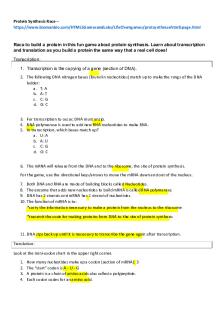F20 S03 Protein Structure Worksheet PDF

| Title | F20 S03 Protein Structure Worksheet |
|---|---|
| Course | Introductory Biology: Cell And Developmental Biology |
| Institution | Cornell University |
| Pages | 2 |
| File Size | 98.4 KB |
| File Type | |
| Total Downloads | 83 |
| Total Views | 145 |
Summary
Download F20 S03 Protein Structure Worksheet PDF
Description
BIOMG1350 Section 7: Protein Structure Worksheet
Name: ____Alina Abramoff_______________
Section: _____213________
Introduction to PyMOL, Protein Folding, and Protein Structure/Function
Fill in the colors you selected for 1HCK in steps 2-5 in the table below, then answer question 1. You will fill in the column for 1FIN (Bound) later in the exercise.
Color Chart 1HCK (unbound CDK) ATP T-Loop Glutamic Acid CDK_2 (bound CDK) Cyclin
1HCK (unbound) Red Blue Purple Yellow n/a n/a
1FIN (Bound) n/a Cyan Hot pink Limon Orange Green
Q1: In an active Cdk molecule, glutamic acid interacts with ATP to help transfer a phosphate group to a target protein. Look at the orientation of the glutamic acid side chain. Is it oriented toward or away from the ATP? Do you think it can interact with ATP in this orientation?
The glutamic acid is oriented away from the ATP. I think it cannot interact with ATP in this orientation Part 2: Complete steps 7-9, fill in the colors in the table above, and answer the following question. Q2: Look at the glutamic acid residue. Is the glutamic acid side chain pointing towards or away from the ATP molecule? How is this different from where the glutamic acid residue was oriented in the CDK molecule without bound cyclin? Do you think that the glutamic acid residue can interact with ATP in this orientation? The glutamic acid side chain is pointing towards the ATP molecule. This is different from the CDK molecule, because without the bound cyclin, the glutamic acid side chain was pointing away from the ATP. In this orientation, the glutamic acid residue can interact with the ATP.
Complete step 10 and answer the following question. Q3: Compare the backbones (ribbons) of the unbound Cdk and the cyclin-bound Cdk. Can you see the conformational change that occurred? (Hint: remind yourself which ribbons are the unbound Cdk and the cyclin-bound Cdk.)
Yes, I can see conformational change that occurred.
BIOMG1350 Section 7: Protein Structure Worksheet
Complete step 11 and answer the following question. Q4: Has the position of ATP itself changed? The ATP is in a very similar position, but the orientation slightly differs. Complete step 12 and answer the following question. Q5: How does the T-loop move in relation to ATP when cyclin binds Cdk? (Hide and show the T_loop_1 to get a better idea of exactly how the T-loop has changed position.) The T-loop moves in relation to ATP, because in the unbound Cdk, the ATP is blocked/covered, but in the bound Cdk, the T-loop moves to open space for ATP.
Complete step 13 and answer the following question. Q6: Rotate the molecule to find the ATP. How has the cleft (i.e., the opening) where ATP is located changed? Do you think target proteins can access ATP in this conformation? The cleft where the ATP is located became wider; therefore, making the ATP be more out in the open and making it easier for target protiens to access it.
Complete step 18 and answer the following questions. Q7: Describe where the ATP is positioned within the Cdk molecule (is it sticking out?): ATP is not sticking out. The ATP When cyclin binds Cdk, it causes a conformational change that moves the position of the T-loop. How do you think this affects the ability of proteins to bind Cdk and access the ATP molecule? (1 sentence max!)
Q8: Thinking back to everything you just did, is the movement of the T-loop the only conformational change that occurs in Cdk when cyclin binds? If not, what other conformational changes did you observe? (1-2 sentences max!) The T-loop changes its position; however, the ATP changes its orientation slightly....
Similar Free PDFs

Worksheet 9 - Protein structure
- 7 Pages

Protein Structure
- 3 Pages

Protein structure notes
- 2 Pages

6 Fermentation worksheet F20
- 4 Pages

6 Fermentation worksheet F20 3
- 3 Pages

4 levels of Protein structure
- 2 Pages

Protein Synthesis Worksheet
- 1 Pages

Protein Worksheet with Answers
- 4 Pages

Earths structure worksheet
- 2 Pages

Cell Structure Worksheet
- 1 Pages
Popular Institutions
- Tinajero National High School - Annex
- Politeknik Caltex Riau
- Yokohama City University
- SGT University
- University of Al-Qadisiyah
- Divine Word College of Vigan
- Techniek College Rotterdam
- Universidade de Santiago
- Universiti Teknologi MARA Cawangan Johor Kampus Pasir Gudang
- Poltekkes Kemenkes Yogyakarta
- Baguio City National High School
- Colegio san marcos
- preparatoria uno
- Centro de Bachillerato Tecnológico Industrial y de Servicios No. 107
- Dalian Maritime University
- Quang Trung Secondary School
- Colegio Tecnológico en Informática
- Corporación Regional de Educación Superior
- Grupo CEDVA
- Dar Al Uloom University
- Centro de Estudios Preuniversitarios de la Universidad Nacional de Ingeniería
- 上智大学
- Aakash International School, Nuna Majara
- San Felipe Neri Catholic School
- Kang Chiao International School - New Taipei City
- Misamis Occidental National High School
- Institución Educativa Escuela Normal Juan Ladrilleros
- Kolehiyo ng Pantukan
- Batanes State College
- Instituto Continental
- Sekolah Menengah Kejuruan Kesehatan Kaltara (Tarakan)
- Colegio de La Inmaculada Concepcion - Cebu





